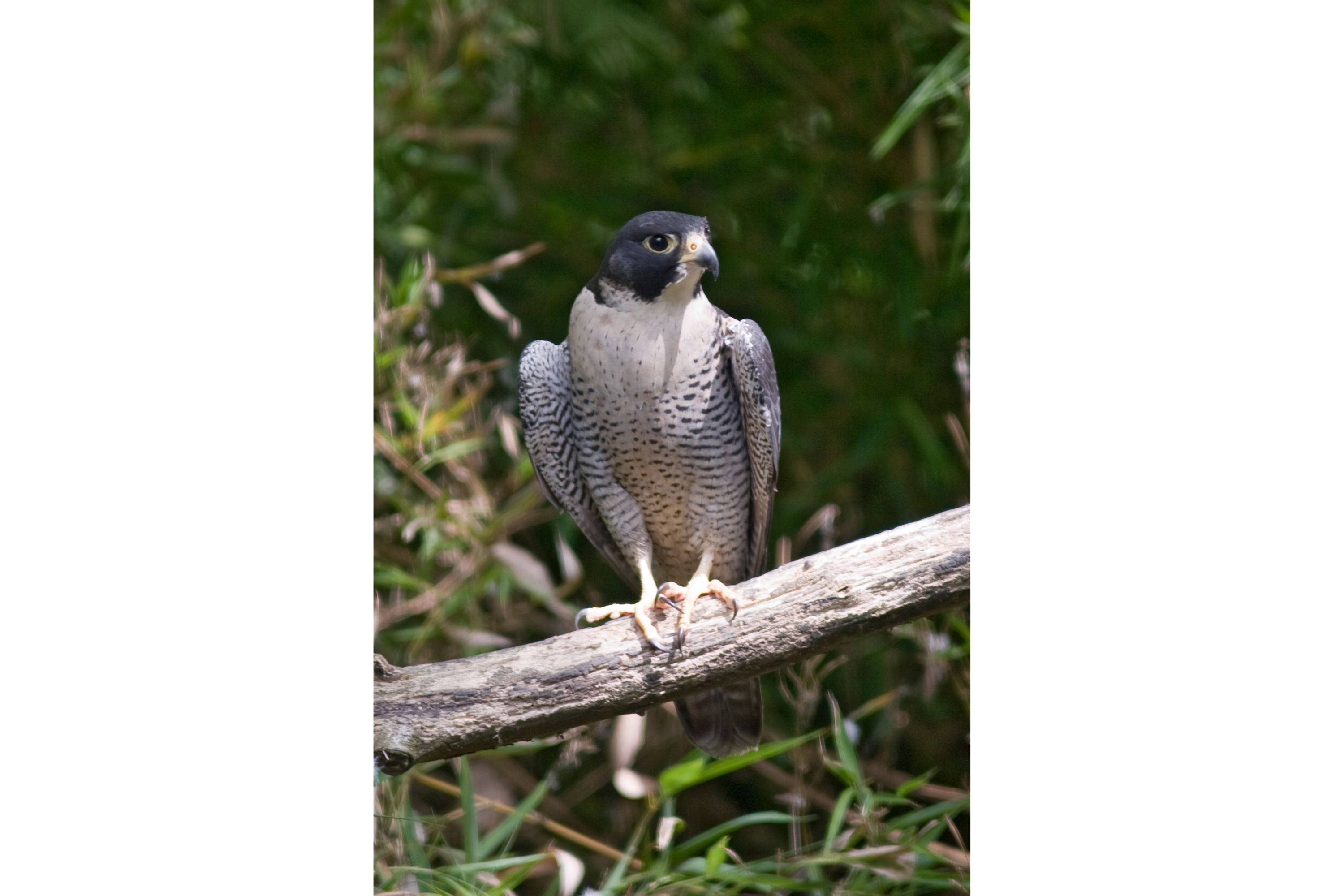Peregrine falcon
(Falco peregrinus)

Description
Falco peregrinus, commonly known as the peregrine falcon, is a majestic bird of prey that is highly regarded by bird enthusiasts and conservationists around the world. As the fastest animal on earth, the peregrine falcon has captured the hearts and minds of many people, and is often considered a symbol of power and agility. In this article, we will explore the various aspects of this magnificent bird, including its physical features, habitat, behavior, diet, and conservation status. Physical Features The peregrine falcon is a medium-sized bird of prey that measures between 35-50 cm in length and has a wingspan of 80-120 cm. The male is slightly smaller than the female, weighing between 330-500 grams, while the female weighs between 500-1200 grams. Peregrine falcons have a dark blue-gray back and wings, with a white throat and underparts that are spotted with black. Their head is black with a distinctive black mustache mark, and they have sharp, hooked beaks and powerful talons. Their wings are long and pointed, which allows them to fly at high speeds and maneuver with great agility. Overall, their physical features are well-suited for hunting and catching prey, particularly in mid-air. Habitat Peregrine falcons are found on every continent except Antarctica, and they are known for their adaptability to a wide range of habitats. They can be found in coastal regions, mountains, forests, and even urban areas, where they have adapted to nesting on tall buildings and skyscrapers. In North America, peregrine falcons were once found in large numbers across the continent, but their populations declined sharply in the mid-20th century due to the widespread use of pesticides. However, thanks to conservation efforts, their populations have rebounded in recent years. Today, they can be found in a variety of habitats, from wilderness areas to urban centers, and they continue to adapt to changing environments. Behavior Peregrine falcons are known for their incredible speed and agility, and are among the fastest animals on earth. They are capable of reaching speeds of up to 320 km/h when diving to catch their prey, making them the fastest animal in the world. In addition to their speed, peregrine falcons are also known for their hunting skills, which include catching birds and other prey in mid-air. They are also known for their territorial behavior, with pairs of birds defending their nesting sites vigorously. Peregrine falcons are monogamous and form strong pair bonds, with both male and female birds contributing to nesting and rearing their young. During the breeding season, peregrine falcons engage in spectacular aerial courtship displays, which involve flying together in a series of acrobatic maneuvers, often high in the air. These displays are thought to reinforce pair bonds and establish territories. Peregrine falcons are also known for their aggressive behavior when defending their young or territories. They have been observed attacking other birds, including much larger species, such as eagles and hawks, that pose a threat to their nests or young. Overall, the behavior of Falco peregrinus is well-suited for their role as efficient and successful predators, and their remarkable speed, agility, and territorial behavior make them an impressive and awe-inspiring species to observe. Diet Peregrine falcons are carnivores, and their diet primarily consists of birds, although they have been known to eat small mammals and insects as well. Their hunting strategy involves soaring at high altitudes, scanning the landscape for potential prey, and then diving at incredible speeds to catch their target. They can catch birds in mid-air, striking them with their powerful talons and killing them instantly. Peregrine falcons feed on a wide variety of bird species, including pigeons, doves, grouse, ducks, and songbirds, among others. They often prey on birds that are smaller than themselves, but have also been known to take down birds that are much larger, such as ducks and geese. Their diet can vary depending on the habitat they live in, with coastal populations feeding on seabirds and inland populations feeding on birds that are found in those areas. In urban areas, peregrine falcons have also been known to feed on feral pigeons and other city birds. Falco peregrinus are highly skilled hunters with a diverse diet that allows them to thrive in a wide range of habitats. Conservation Status The conservation status of peregrine falcons has improved significantly in recent decades. During the mid-20th century, their populations declined sharply due to the widespread use of pesticides, such as DDT, which had devastating effects on many bird species, including peregrine falcons. By the 1960s, peregrine falcons had disappeared from many areas of their range, including most of the eastern United States and much of Europe. However, since the banning of DDT and other harmful pesticides, peregrine falcon populations have made a remarkable recovery, and their conservation status has improved significantly. They have been successfully reintroduced to many areas of their former range, and their populations are now considered stable or increasing in many parts of the world. The International Union for Conservation of Nature (IUCN) currently lists peregrine falcons as a species of "Least Concern," indicating that their populations are now considered healthy and stable. However, continued conservation efforts are needed to ensure their populations remain healthy, particularly in areas where they may still face threats such as habitat loss or persecution. The recovery of peregrine falcon populations is a remarkable conservation success story, and serves as an important reminder of the importance of environmental conservation and the need to protect endangered species. Conclusion In conclusion, the peregrine falcon is a remarkable bird that is highly regarded by bird enthusiasts and conservationists around the world. With its incredible speed and agility, this bird is a symbol of power and grace, and is often used to represent the ideals of strength and freedom. While their populations declined sharply in the mid-20th century, conservation efforts have led to their recovery, and today they continue to thrive in many parts of the world.
Taxonomic tree:







